Best compact binoculars 2024: Lightweight, travel-friendly models
The best compact binoculars offer fantastic views in a lightweight, small package without compromising on image quality — check out our favorite models.
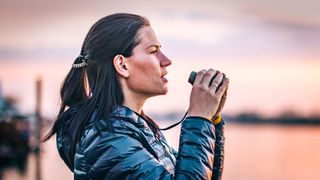
1. The list in brief ↴
2. Best overall
3. Best for portability
4. Best value
5. Best budget option
6. Best for glasses wearers
7. Best waterproof model
8. Best styling
9. Best for travel
10. Compact binos FAQ
11. How we test
If you're in the market for a pair of the best compact binoculars, you've come to the right place. We've rounded up the very best of them here, covering a wide range of specifications and price ranges.
Why choose compact binoculars instead of regular ones? The reason is usually pretty straightforward: Portability. Compact binoculars are way smaller than the bigger ones, which makes them perfect for travel. They easily fit into your pocket and are just more convenient to carry around.
They're much lighter too, so they're perfect for taking along on day trips or packing in your backpack for vacations. And don't worry about sacrificing quality just because they're small! A lot of the top compact binoculars offer excellent optical performance. We've made sure that only the ones we'd personally recommend are on this list.
Our expert reviewers have tried and tested these binoculars out in the field, considering factors like weatherproofing, size, weight and price when they give their rating. There are some great budget options in this guide, or you can check out our binoculars deals page for deals on some of the best binoculars and best binoculars for kids.
If your interests are more niche, you might want to look at our guide to the best night vision binoculars and best rangefinder binoculars, both great for wildlife watching and nighttime photography. If you're more into stargazing, check out our guides to the best telescopes and best telescopes for deep space.

Jase Parnell-Brookes is an award-winning photographer, educator and writer based in the UK. They won the Gold Prize award in the Nikon Photo Contest 2018/19 and was named Digital Photographer of the Year in 2014. After completing their Masters Jase has spent a good chunk of two decades studying and working in photography and optics shooting and writing all over the world for big-name brands and media outlets. Now the Channel Editor for Cameras and Skywatching at Space.com their speciality is in low light optics and camera systems.
The quick list
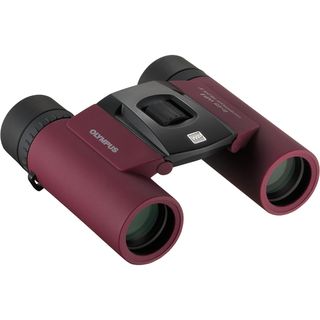
Best overall
For casual skywatchers, the portable Olympus 8x25 WP II boasts an excellent optical system for clear views of the moon and bright targets with superb contrast.
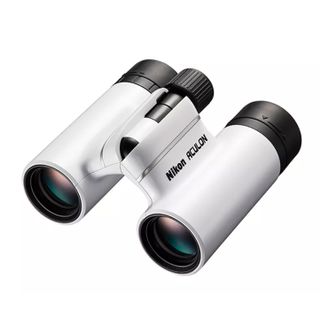
Best for portability
These small and stylish binoculars bring a model from a quality brand into the affordable range. They are easy to tuck into a pocket at just 3.4 x 4.1-inches in size.
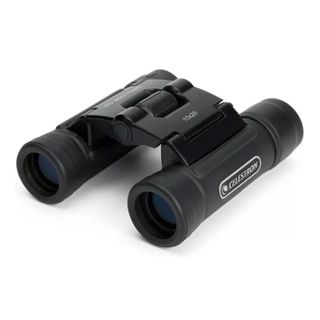
Best Value
These 10x binoculars perform better than their 8x counterpart due to their better twilight factor — 15.8 instead of 13.0 for better low-light results.
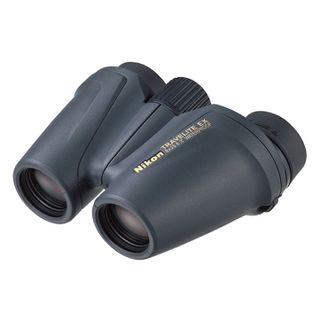
Best budget option
More than suitable for multi-purpose daytime use and some astronomy viewing, these pocket-sized binoculars are compact and well-made.
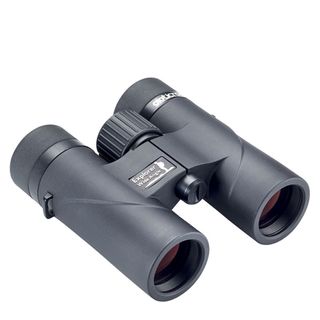
Best for glasses wearers
With a generous 18mm of eye relief, these binos from Opticron produce bright, contrasty images and are ideal for wildlife observation.
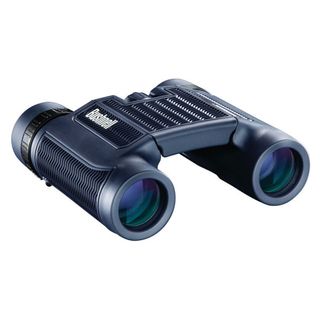
Best waterproof model
With Multi-coated optics and a waterproof and fog-proof design these compact binoculars from Bushnell feature BaK-4 glass and multi-coated optics.
Load the next 2 products ↴
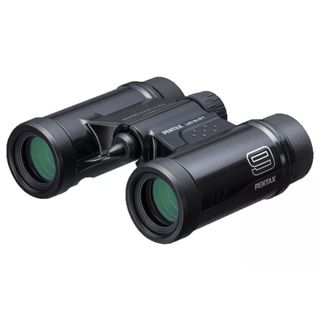
Best styling
We love the design, colors, and light weight of these Pentax UD compact binoculars. They're fully multi-coated, too.
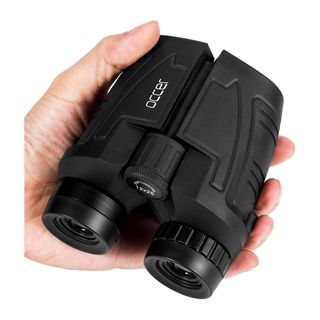
Best for travel
Tiny but still offer fantastic clarity and performance to compete with the big-name brands, they have plenty of grip for use in all weathers.
Best compact binoculars we recommend in 2024
Why you can trust Space.com
Best overall





Specifications
Reasons to buy
Reasons to avoid
✅ You're a keen wildlife observer: They'd be a great purchase for anyone who loves nothing more than observing wildlife and taking in the surroundings while trekking.
❌ You want to do some stargazing: They lack the light-gathering prowess needed for dedicated skywatching, so we'd recommend opting for a more suitable option.
🔎 Olympus WP II 8x25: The Olympus 8x25 WP II's seamless housing and exquisite optical system offer small but clear, crisp views of bright targets with stunning contrast. ★★★★½
The Olympus WP II 8x25 compact binoculars sit at the top of our list thanks to their fantastic optics. No matter what your subject is, you'll find clear and crisp views through these, with good contrast and high color fidelity to boot.
While these binoculars might not be the best for stargazing due to their 8x magnification and 25mm objective lenses, which don't gather enough light for serious nighttime observation, they're still great for casual use and offer solid performance for a variety of different subjects.
These binoculars are super lightweight at just 9 oz. (260g) and have a rubber-coated finish that makes them easy to grip, perfect for long viewing sessions. They feel sturdy and well-made despite their light weight. You can take them on hikes or use them for wildlife watching because they're fog-proof, waterproof and filled with nitrogen. We tested them in pretty challenging weather conditions and didn't have any problems with water or fogging at all.
The high-quality BaK-4 roof prism design with fully multi-coated lenses offers small but detailed views of bright night sky objects of at least +4.0 magnitude. The field of view measures 6.2 degrees, so you'll fit about 12 moon widths in the view to give you an idea of scale.
During our Olympus 8x25 WP II review, we were pleased to see no color fringing, and the adjustable eyecups offer a 15mm eye relief, making them suitable for use with glasses. If you're looking for versatile binoculars with excellent optics, these are a great option. However, if you're specifically interested in stargazing, there might be better choices available.
- Read our full Olympus 8x25 WP II review
| Attributes | Notes |
|---|---|
| Design | Lightweight, portable design. |
| Performance | Small, crystal clear views with good contrast. |
| Functionality | Low light-gathering prowess. |
Best for portability







Specifications
Reasons to buy
Reasons to avoid
✅ You want to travel with them: These binoculars are small and lightweight, so they're extremely easy to carry around with you.
❌ You want something for all weathers: They are not waterproof, so if you want to use them outside in any weather, consider another pair.
❌ You need to wear your glasses when using binoculars: The 10.3mm eye relief isn't very glasses-friendly, so a different model would be better.
🔎 Nikon Aculon T02 8x21: Despite minor flaws, their attractive design, high portability and good optics make them worth considering. ★★★★½
While the Nikon Aculon didn't quite make our top spot, they're a serious contender amongst our picks of the best compact binoculars — and they're even at a slightly lower price point than the Olympus pair. So if you're conscious of budget, perhaps these might be your top consideration.
These binoculars are incredibly compact, measuring just 3.4 x 4.1 inches (8.6 x 10.4cm) and weighing only 6.9oz (196g). They're so small and light that you'll hardly feel them in your bag, and they slip into pockets as easily as a smartphone. They come in various colors and are comfortable to hold for long periods. Plus, their small size and durability make them perfect for kids.
They're quite sturdy, with a rugged body that can withstand rough handling. While they're not waterproof, they should hold up fine in light rain. Plus, they're nitrogen-filled to prevent fogging. Their durability, combined with their relatively low cost, makes them a solid choice for children. You can even pick the color of the body from a few options, adding a touch of personalization. It's not essential, but it's a neat feature to have.
The optics impressed us in our Nikon Aculon T02 8x21 review, giving pin-sharp views of the moon with just a little chromatic aberration along the lunar limb which was barely noticeable. The focuser is very accurate and allows for minute movements to get your object of interest perfectly in focus, and they also have excellent color fidelity.
The Nikon Aculon has a couple of design drawbacks. With only a 10.3mm eye relief, they're not great for people who wear glasses while using binoculars. Also, if you're into stargazing, they might not be the best choice because they don't gather enough light to see fainter celestial objects, and they don't have BaK-4 prisms like some other models.
- Read our full Nikon Aculon T02 8x21 review
| Attributes | Notes |
|---|---|
| Design | Lightweight and pocketable. |
| Performance | Good optics and accurate focuser. |
| Functionality | Not waterproof, bad for heavy downpours. |
Best value

Celestron UpClose G2 10x25
Our expert review:
Specifications
Reasons to buy
Reasons to avoid
✅ You want to do some stargazing: They give great low light results thanks to their higher twilight factor.
❌ You want the highest specs: Budget binoculars don't tend to have the best specs — if that's what you want, you're going to have to part with more cash.
🔎 Celestron UpClose G2 10x25: Not the highest spec compared with models on this list — you will get partially multi-coated lenses and BK-7 glass roof prisms. Still, they are well-priced and come with the reassurance of a limited lifetime guarantee. ★★★★½
We're used to finding Celestron in our lists since the company is known for its high-quality telescopes and binoculars. But we felt their UpClose G2 binoculars were particularly worthy of note for offering a great range of features at an affordable sub-$30 price point.
These binoculars have a sleek and compact design, measuring just 3.0 x 2.2 x 4.5 inches (76 x 51 x 114mm), so they're super easy to take with you anywhere. If you wear glasses, you'll like the fold-up eyecup design, which lets you fold the eyecups down when you're wearing your glasses. Plus, they're rubber-coated for added durability.
Even though they're small and affordable, these binoculars have a surprisingly high twilight factor of 15.8, meaning they work really well in low light. They're great for stargazing but also versatile enough for other activities. With 10x magnification and a close focus of just 15 feet, they're perfect for wildlife observation. Compared to the UpClose G2 8x21, which has a lower twilight factor of 13, we'd suggest going for these binoculars instead.
These compact binoculars don't have the most advanced specs on this list, but for the price, you're getting a fantastic deal. Their lenses are partially multi-coated rather than fully coated, and they use BK-7 glass roof prisms rather than superior BaK-4 glass. But these are trade-offs expected for this price point, and despite them, the Celestron UpClose G2 10x25 still performs admirably. Whether you're a beginner or on a very tight budget, they're a good choice.
We haven't reviewed the 10x25 yet, but we have reviewed the Celestron UpClose G2 10x50, which we loved for astronomy.
- Discover the cosmos using one of the Best stargazing apps
| Attributes | Notes |
|---|---|
| Design | Compact with fold-up eyecups. |
| Performance | Good in low-light conditions. |
| Functionality | Economy BK-7 glass but 10x magnification. |
Best budget option





Specifications
Reasons to buy
Reasons to avoid
✅ You're a casual viewer: For a decent grab-and-go pair that will serve you well for casual day and nighttime viewing, these are a good option.
❌ You're a serious skywatcher: If you want to take your stargazing to the next level, you'll likely outgrow them quickly.
🔎 Nikon Travelite EX 8x25: These pocket-sized binoculars are compact, well made and lightweight, making them a handy accessory, but unfortunately — due to their small 25mm aperture — we could not see much celestial detail. ★★★★
The Nikon Travelite EX 8x25 compact binoculars are a great budget option for casual users or beginners. They're sturdy and well-made, coming from a brand with excellent pedigree. They have a surprisingly wide field of view given their small size — and we also love that they come with a carry case, making them ideal for travel.
In our Travelite EX 8x25 review, we praised the eye relief of these binoculars, stating they're great for glasses-wearers. The eyecups feature O-ring seals, which are nitrogen-filled to prevent fogging, and there's also waterproofing up to a depth of two meters for five minutes — if you're using them near a body of water, then, you don't need to stress too much about accidentally dropping them in (though of course try not to!).
For stargazing, these binoculars give you a nice view of the night sky with a 6.2-degree field of view, wide enough to see all three stars in Orion's belt. We could even spot the craters on the Moon, and because they're lightweight, there's no shaking to ruin the view like you might get with heavier binoculars.
You need to be realistic about what you can see in the night sky with these binoculars. Their 25mm aperture means they're not the best for seeing detailed objects like Saturn's rings, and you might find bigger binoculars at a similar price that give you better views. So, we'd suggest these mainly for casual stargazers or anyone who needs a portable pair for different uses. If you're really serious about skywatching, you might want to look into other options.
- Read our full Nikon Travelite EX 8x25 binoculars review
| Attributes | Notes |
|---|---|
| Design | Sturdy and durable, with a rubberized coating. |
| Performance | Very good contrast when observing bright objects. |
| Functionality | Lacks great light-gathering power but has decent night-sky views. |
Best for glasses wearers

Opticron Discovery WA ED 8x32
Our expert review:
Specifications
Reasons to buy
Reasons to avoid
✅ You wear glasses: They have a generous 18mm of eye relief.
✅ You're a keen wildlife observer: They're very well-rated for birdwatching or for using on safari.
❌ You want the most lightweight option: If you need to be nitpicky about weight, there are lighter options on this list.
❌ You're on a budget: They're quite expensive for compact binoculars.
🔎 Opticron Discovery WA ED 8x32: Very generous eye relief for users who wear glasses, and produce bright, contrasty images, although sharpness does drop off at the edges of the frame. ★★★★
For users who need to wear glasses all the time, the eye relief on a pair of binoculars is quite an important specification, as it can determine how comfortable they will be to use when you're using them while wearing glasses, which can make or break how much use you get out of them.
Generally, an eye relief of around 16mm and over is suitable for people who wear glasses, and the Opticron Discovery WA ED 8x32 have a very generous 18mm of eye relief, which makes them a great option — they're actually the only pair of binos on this list that have over 16mm.
They provide bright images that are contrasty and sharp in the center, although not quite as good of a picture as you'd get with a larger pair of binos. Still, if you want a lightweight and compact binocular to take on camping trips that you can easily slip into your pocket, that's sometimes a necessary sacrifice.
They're textured to provide a good grip, although they may be a little small for larger hands. But that said, if you have large hands you'll struggle with most compact binoculars anyway.
They are the most expensive on this list by a fair way, but they also have the largest objectives so more light can pass through. We think this would make them fine for low light use, although the 8x magnification wouldn't be good for much more than a quick sweep across the sky to see the stars or the moon.
- Unearth distant celestial objects by reading our guide to the Best telescopes for deep space
| Attributes | Notes |
|---|---|
| Design | Nicely textured and feels good in the hand. |
| Performance | Bright and sharp images. |
| Functionality | Very generous eye relief. |
Best waterproof model

Bushnell H20 8x25
Our expert review:
Specifications
Reasons to buy
Reasons to avoid
✅ You use them in all weathers: These binos are hardy and water and fog-proof, so you can rely on them in any weather.
❌ You wear glasses: The eye relief on these binos isn't the best, so if you wear glasses, there are better options.
❌ You want something pocketable: While they're fine for tossing into your bag, they're probably a little large to fit into your pocket.
🔎 Bushnell H20 8x25: Impressive specifications for a very reasonable price, including multi-coating (though not fully multi-coated) and BaK-4 roof prisms. ★★★½
The Bushnell H20 8x25 compact binoculars come with impressive specs considering their affordable price. Featuring BaK-4 roof prisms and partial multi-coating, they offer clear and sharp views, making them enjoyable to use. With a 6.9-degree field of view, they provide a pretty decent viewing experience, in our opinion.
They're also comfortable to use thanks to their large, easy-to-grip center focus knob. You can use that to make adjustments, and we've found it's easy to use even when you're wearing gloves given its size — perfect if you're using them on a chilly winter evening.
While they're not exactly pocket-sized at 127 x 101.6 x 69.5mm, these binoculars are still compact and easy to toss into your backpack for outdoor camping trips. They're waterproof and nitrogen-purged to prevent fogging, and Bushnell provides a manufacturer's guarantee for added peace of mind.
With a 12mm eye relief, the Bushnell H20 8x25 might not be the most suitable option for glasses wearers. However, they do have a rubberized, textured coating that protects against bumps and improves grip.
- Save money with these Bushnell binoculars deals
| Attributes | Notes |
|---|---|
| Design | Hardy and waterproof. |
| Performance | Multi-coated and BAK4 glass. |
| Functionality | Eye relief a bit short for glasses. |
Best styling

Pentax UD 9x21
Our expert review:
Specifications
Reasons to buy
Reasons to avoid
✅ You want something small: These binos are tiny and lightweight, so will serve you well when traveling.
❌ You want high magnification: While they aren't bad in terms of magnification, there are certainly better options out there if that's what you're after.
🔎 Pentax UD 9x21 If you're struggling to choose between the easier-to-hold 8x magnification or 10x magnification for closer views (especially noticeable on the moon and planets), then here's a compromise — 9x magnification, offering most of the benefits of both. ★★★½
The Pentax UD 9x21 offer a great middle ground between 8x magnification, which can be easier to hold, and 10x magnification, which offers a more detailed view of the moon and planets. The 9x magnification on these binoculars gives users the best of both worlds, and they come with high-quality optics that are fully multi-coated as well.
These binoculars are perfect if you're looking for something super lightweight. They're made with a plastic frame instead of metal and have two small thumb rests for grip instead of rubber armor. Because of this design, they weigh just 195g and measure 10.8 x 8.7 x 3.8 cm, making them incredibly easy to carry around with you and fit comfortably into your pocket.
Given how light and small these binoculars are, we're quite impressed with their performance. They feature a sizable focus wheel that's very user-friendly; just two turns cover the entire focus range. It's worth mentioning that although they're small and compact, they do have a tripod mount. However, you'll need to buy an adapter separately if you want to use it.
The Pentax UD 9x21 binoculars provide a six-degree field of view, which we think is decent. However, it's worth mentioning that it's not as wide as some other compact binoculars. There's also a 10x21 version, but we suggest going for the 9x21 because it has better eye relief and comes with multi-coated lenses, which make the images clearer.
One neat thing to note about these compact binoculars is that they come in some bold colors, including orange, lime green and hot pink. They're always easy to spot, and will likely be more appealing to kids as a result.
- Complement your binoculars with one of the Best telescopes
| Attributes | Notes |
|---|---|
| Design | Lightweight plastic build with fun colors. |
| Performance | Large and accurate focus wheel. |
| Functionality | Includes a tripod mount. |
Best for travel





Specifications
Reasons to buy
Reasons to avoid
✅ You want to take them everywhere: They are incredibly small and lightweight, perfect for taking hiking or on camping trips.
❌ You wear glasses: They have short eye relief, so not ideal if you wear glasses.
❌ You want to use them in all weathers: Although they do claim to be waterproof, we weren't convinced. They'd be fine for light rain but do so at your own risk.
🔎 Occer 12x25: Surprisingly, the Occer 12x25 binoculars offer good quality views considering their tiny design. They are ideal for keeping in your pocket and the perfect size for children and small hands. ★★★½
You may not have heard of Occer before, but they've made a strong entrance into the compact binoculars scene. These binoculars, only 110 x 50mm in size, are super small, which is great for travel or carrying in your pocket outdoors. Plus, their compact design and ability to see things up close make them ideal for kids too, offering impressive features in a tiny and compact package.
Despite the off-putting packaging, which looks a bit cheap and clumsy, we were pleasantly surprised by the clear and bright views offered when we tested them in our Occer 12x25 compact binoculars review. They even had less chromatic aberration than some better-known competitors, and we certainly thought they held their own at such an affordable price point.
They can offer decent views of the Moon and its craters but, as is often the case with compact binoculars, they don't let in enough light for serious stargazing.
Unfortunately, these binoculars don't include lens caps for the objectives or covers for the eyepieces. This might make it challenging to protect them, especially if you're carrying them in a pocket with keys or other items that could scratch the lenses. Also, we found that the eyecups fold down too easily when you apply pressure while using them — we wish they were more sturdy.
But for the price, they would make a good pair for general uses like sport or nature observation and would also be a great choice as an affordable kid's pair.
- Read our full Occer 12x25 compact binoculars review
| Attributes | Notes |
|---|---|
| Design | Lots of texture provides grip. |
| Performance | Bright and colorful views. |
| Functionality | Short eye relief. |
Compact Binoculars FAQ
Which compact binoculars are the best?
Although we've rounded up the best compact binoculars in this useful guide, you may be wondering 'which compact binoculars are the best for me?' The main things to consider when shopping for compact binoculars are the binocular numbers. That is: Magnification — usually 8x or 10x and sometimes referred to as power— and the diameter of the objective (front) lenses. Because compact binoculars are small and light, it's easier to hold them still and so you don't need to worry about higher magnification causing unusable wobble, negating the need for a tripod. Remember though, lower-power binoculars will give a brighter image, making faint objects such as nebulas more visible.
- Related: How to hold binoculars steady
What size binocular lens should I buy?
It is best to go for the largest lens diameter you can get. Bigger lenses mean more light-gathering power and thus better views for you. Compact binoculars tend to have objectives in the 20-25 mm range. However, it is worth noting that even the largest of these will collect only a quarter as much light as a pair of conventional 50 mm binoculars. We don't recommend compact binoculars with a zoom feature, as this is simply asking too much of the smaller objective lenses on this type of instrument.
What type of compact binoculars should I get?
Compact binoculars are usually roof prism types, as this arrangement provides straight tubes and lends itself to foldability. It is rare to find conventional Porro prism compact binoculars, but some use the reverse-Porro arrangement, resulting in objective lenses closer together than the eyepieces. Check what type of glass the prisms are made from; the best you can get is BaK-4, while budget binoculars often use BK-7 or K9 (these two are more or less equivalent).
What's the difference between multi-coated or fully coated optics?
You should consider the type of lens coating that is used. Lenses will be described as coated, multi-coated, or fully multi-coated. The best will be fully multi-coated with phase coating on the prisms. The best will also be nitrogen-filled to eliminate the risk of internal fogging. Some compacts are waterproof or water-resistant, which is always a good idea for use in all weather and gives the user extra peace of mind.
Which brand of binoculars are best?
When shopping online, you may come across lots of lesser-known brands offering what seem to be unmissable bargains but, as ever, buyer beware. Products are not always described accurately, particularly when sold by traders on third-party websites, and we advise treating claims with suspicion. Ask yourself if you believe these very cheap binoculars have all the features they claim or whether some of the claims might be lost in translation.
Sometimes the comfort of a trusted, known brand that offers a warranty is worth paying that little bit extra for. That said, you will see a couple of models in this guide that are lesser known but that we've reviewed and would recommend as good-value-for-money.
How we test the best compact binoculars
To guarantee you're getting honest, up-to-date recommendations on the best compact binoculars to buy here at Space.com, we make sure to put every binocular through a rigorous review to test each instrument fully. Each telescope is reviewed based on many aspects, from its construction and design, to how well it functions as an optical instrument and how it performs in the field.
Each pair of binoculars is carefully tested by our expert staff or knowledgeable freelance contributors who know their subject areas in depth. This ensures fair reviewing is backed by personal, hands-on experience with each binocular and is judged based on its price point, class and destined use. For example, comparing a pair of 25x100 mammoth binoculars to a compact pair of 8x25s wouldn't be appropriate though each binocular might be the best pick in their own class.
We look at how easy they are to operate, whether the length of eye relief can be adjusted for spectacles wearers (the longer the better) if a binocular comes with appropriate accessories (lens caps, neck strap, cleaning cloths) or carry bags and also make suggestions if a particular set of binos would benefit from any additional kit to give you the best viewing experience possible.
With complete editorial independence, Space.com are here to ensure you get the best buying advice on binoculars, whether you should purchase an instrument or not, making our buying guides and reviews reliable and transparent.
Today's best deals
Join our Space Forums to keep talking space on the latest missions, night sky and more! And if you have a news tip, correction or comment, let us know at: community@space.com.
Get the Space.com Newsletter
Breaking space news, the latest updates on rocket launches, skywatching events and more!

Jase Parnell-Brookes is an award-winning photographer, educator and writer based in the UK. They won the Gold Prize award in the Nikon Photo Contest 2018/19 and was named Digital Photographer of the Year in 2014. After completing their Masters Jase has spent a good chunk of two decades studying and working in photography and optics shooting and writing all over the world for big-name brands and media outlets. Now the Channel Editor for Cameras and Skywatching at Space.com their speciality is in low light optics and camera systems.
- Kimberley LaneContributing writer
- Tantse WalterContributing Writer
- Kimberley SnaithFreelance contributor